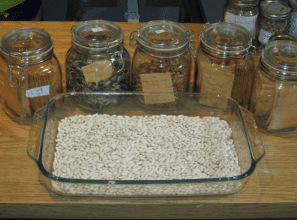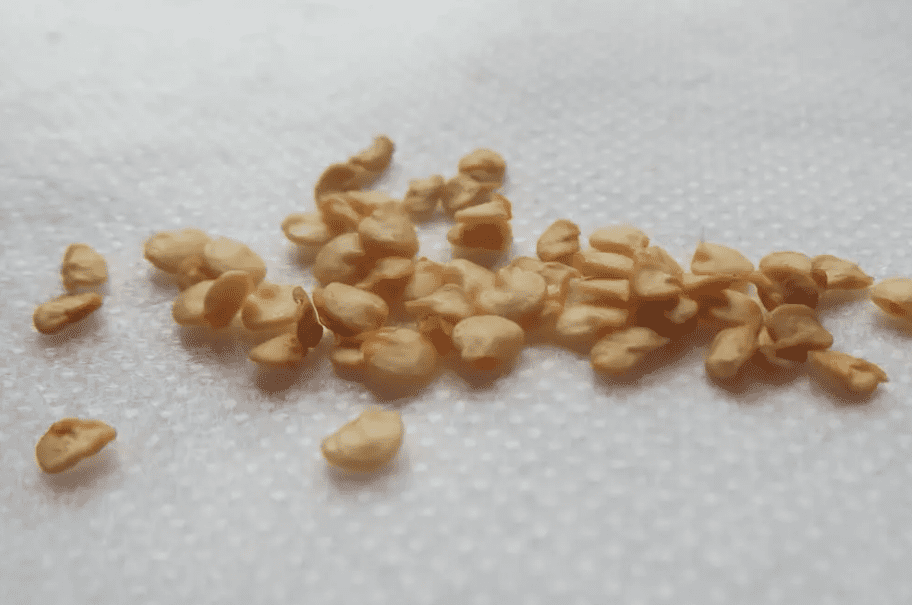Before planting, seeds should be dried to protect the insides and aid in germination and the development of a healthy seedling.

Because the drying process hardens and seals the protective shell around interior sections, seeds that are dried before planting have a better chance of germinating. On a spotless surface, seeds should be dried for two to three weeks in indirect sunlight. When kept in the proper circumstances, dried seeds can be kept for up to five years.
The seeds may rot if there is an excess of moisture and humidity.
We must guard the covered skin, which guards the grain when planting seeds. The covered skin of undried seeds is easily removable.
The seed will decay as a result and may not grow if planted. Wet seeds are also particularly vulnerable to certain illnesses and pests.
We’ll go over exactly how to dry seeds so that they avoid a variety of issues and sprout successfully.
If you’re interested in safely drying seeds, we recommend a cheap rack from Amazon that works well without letting bugs eat the seeds. Clicking here will take you there.
Table of Contents
Do Seeds Need to be Dried Before Planting?
Before sowing, seeds must be thoroughly dried. This guarantees that the germination process is effective, enabling the plumule to develop into shoots securely.
The cotyledon cradles the embryo (the young plant) in a developing seed until it is prepared to sprout and spread forth.
In order to ensure that the seed is adequately aerated and free from pest damage, it must also be dried outdoors in the open.
Among the advantages of drying seeds are:
- It is now simple to germinate the seeds.
- Planting is simple.
- There will be little chance of contamination and infestation.
- Free from rust and damage
- free of viruses and chemicals that affect wet seedlings.
Dried seeds have cotyledons that have good shape and are more likely to germinate and develop into healthy seedlings.
Due to the high moisture level, wet seeds will not adapt properly, leading to rot and damage.
The seed is more functional and viable after being dried before being sown. Stronger plants with larger yields will result from proper drying techniques combined with the appropriate planting depth.
Even though they must be dried, too much drying might damage the seed by hardening the seed coat and making it water-impervious when planted.
Not all seeds can be dried before planting, so keep that in mind.
Some seeds can’t be dried because they require constant moisture in their environment to quickly mature and grow.
Let’s look at several seeds that can be successfully planted after being dried.
Which Seeds Work Well When Dried?
Some fruits require drying, followed by rewetting, in order to be planted successfully.
Other seeds must be completely dried before planting. When sowing, some seeds, like pepper, require moistening.
Before sowing, the seeds listed below must completely dry.
- Pawpaws
- Beans
- Legumes
- Nuts
- Mangoes
- Maize
- Pumpkin
- Peas
- fruit seeds
- Acai berry seeds
- Orange
- seeds from a lemon
How to Dry Seeds Before Planting?
Before laying larger fruits like pumpkins out to dry, the seeds should be taken out.
It is advised to remove the seeds because the larger fruits and vegetables will likely contain too much moisture, which could prevent the seeds from drying properly.
After removal, separate the seeds, wash them, and then place them on a clean plate and allow them to sit for a while without any water.
The seeds should then be placed in a clear polythene bag and left directly exposed to the sunlight in a very open, clear area.
To make sure the seed is thoroughly dry, you should flip them over.
Take them and prepare them for planting after allowing them to sundry for at least two weeks.
Never leave the seeds outside over night as the morning dew can prevent the seeds from drying in the sun.
If the seeds are left outside in the early dew, they will get wet.
To achieve full drying, it is advised that you should dry seeds for around 2 to 3 weeks.
When to Extract Seeds from the Fruit?
When the fruit is fully ripe and developed, the seeds should be removed.
The pollinated fruits that produce edible and fresh fruits are the ones that are well-cared for.
They make it simpler and easier for the individual picking the fruit to get good-quality seeds.
Fruit quality can also be improved by proper storage.
Good seeds can also be produced from good fruit with the proper management during transportation from the field to the home.
When removing the fruit’s seeds, there are a few things that are necessary.
These consist of:
- Be careful how you hold the fruit and avoid overpressing it to prevent harm.
- After that, wash thoroughly.
- Cut the fruit in half carefully to prevent harming the seeds by cutting through them.
- With a clean spoon, remove the seeds and place them in a dish of water to wash them. Any fruit that is still attached to the seed can be easily removed as a result.
- Allow the seeds to settle for at least two days while making careful to check on them frequently to prevent contamination from outside sources.
- To prevent moldy conditions, remove the seeds from the water and place them in a clear polythene bag with a small break in it.
- Allow them to dry completely for a further two weeks.
Make sure the seed is thoroughly removed and is kept in cool, dry areas.
Avoid humid regions because they may render the drying procedure ineffective.

Should Seeds be Dried in Direct Sun or Be Covered?
Yes. Sun drying them is an option. Additionally, they can be protected from any harmful moisture by covering them each day after drying for two to three weeks.
Compared to when they are placed in a jar or polythene, where they transpire more slowly, seeds that are dried in the sun lose moisture more quickly.
Direct sun drying is preferable. The seeds may sweat and regain moisture if you cover them.
However, you must use particular caution in this situation. The seeds should first be dried while the sun is not too strong.
The seeds will perish if you expose them to the direct sun between 12 and 2 p.m. Therefore, we advise drying them outside either before or after this time.
The suggested duration
The seeds can be dried more quickly in the sun than they can under polythene sheets, hence this method is the most effective.
What Keeps Seeds from Drying Out?
Due to the moisture content, the seeds are typically not thoroughly dried off, which can result in mold growth and seed rot.
When it comes to drying seeds, whether or not it is necessary will depend on the fruit from which it was extracted.
Other elements that may impact the drying process include
- climatic circumstances,
- the drying technique,
- The length of time that was allowed for the seeds to dry
- which area is used to dry the seeds.
Human factors like handling and seed kind are minor contributing factors as well.
Additionally, when the seeds are taken out of a fruit or grain that has already been attacked, drying them completely can be quite challenging.
Seeds require great attention and care; even a small obstruction or error might ruin your planting season and your hopes.
How to Determine if the Seeds are Correctly Dried
– Threshing – breaking open or cracking up the pods to release the seeds.To ensure a thorough drying, give them an additional two weeks.
Be sure to remove the seed completely and store it somewhere cold and dry.
To prevent the drying process from being ineffective, avoid humid environments.
Yes. The option to sun-dry them is available. In order to protect them from any harmful moisture, they can also be covered each day after drying for two to three weeks.
Extra tips When Drying Seeds
The seeds dry up more quickly in the sun than they would if they were kept in a jar or a polythene bag, where their moisture loss is more gradual.
Direct sunlight drying is preferred. Covering the seeds may cause them to perspire and regain moisture.
But in this case, you must be especially cautious. The seeds should first be dried during times of low solar radiance.
Since the seeds will be killed by the extreme sun heat between 12 and 2, you should avoid the direct sun at those times. To dry them sooner or after this time frame, we advise doing it outside.
suggested period of time
How Long Can you Store Dried Seeds
In comparison to covering them with polythene sheets, drying seeds in the sun is more effective because it takes less time.
Due to the moisture content, the seeds are generally not thoroughly dried off, which might result in mold growth and seed rot.
If seeds are to be dried, whether they must be dried or not depends on the fruit from which they were extracted.
the drying process can also be affected by other factors, such as
environmental factors,
